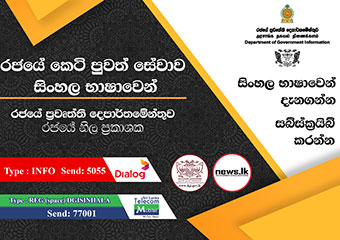There is no doubt that the developments in Geneva, with the build up against Sri Lanka at the UNHRC sessions, did play a considerable role in projecting the critical situation that emerged there into the political situation at home. Yet, the efforts of the opposition parties to use that situation, which led to a defeat for Sri Lanka into an advantage for them, did not succeed. Even though the UPFA fixing the date of the poll immediately after the Geneva sessions could well have been to benefit from it, whether win or lose, the failure of the opposition to use the situation in Geneva to its advantage shows there were other forces at play in these two victories for the UPFA.
What stood out in the entire campaign was the popularity of President Mahinda Rajapaksa, as leader of both the country and the UPFA. A study of media reports of the rival campaigns of the UPFA, UNP, JVP and the DP, the crowd presence at rallies, the organizational activities at the grass roots levels, as well as the propaganda tactics of the opposition parties, all gave the clearest indication that both the popularity and vote getting capability of Mahinda Rajapaksa had suffered little damage through incumbency. This was against all the standards applicable to the problems faced by incumbency in electoral politics.
Leadership role
When the people of the Western and Southern Provinces went to the polls last Saturday, Mahinda Rajapaksa remained the leader who saw the defeat of the LTTE and ushered in the era of peace after more than three decades of violence. He remained the leader who faced up to the foreign forces that tried to prevent the military defeat of the LTTE in 2009, and later faced up to the same forces in their subsequent efforts to obstruct the process towards reconciliation and the strengthening of peace. Although there are issues about economic progress that give good cause for debate, he also remains the leader under whom the GDP of the country has grown, both during and after the conflict, with a steady rise in per capita income too. He is also seen as the leader under whom there has been a considerable infrastructure development; the most noteworthy and impactful of which is the development of the road and highway network of the country that affects people in all provinces - and had a special relevance to both the Southern and Western Provinces.
If the national and the UPFA leadership of Mahinda Rajapaksa remained unchallenged, there was the other major issue of policy and political strategy. None of the opposition parties had any serious policies to offer the voters of these two provinces, who make up a substantial vote base of both the Sinhala majority and the Tamil and Muslim minorities. They had no positive economic policies to offer the people, although being abundant in criticism of existing policy. The absence of alternative policies to choose from, necessarily kept the bulk of the voters in the camp of the UPFA. On the issue of corruption, about which there was much said by the opposition parties, they were not able to come out with clean hands of their own, having a very poor record on corruption when they, especially the UNP, did hold office. There can be little said for the JVP in this regard because their record in office is too short, and yet not always clean, and nothing at all for the Democratic Party of Sarath Fonseka, who has never had any role in office.
Another important aspect of the Mahinda Rajapaksa leadership in these two elections, which was true of other previous polls led by him in recent years too, was that he stood above both his opponents and most candidates of his own party. There is uncontradicted evidence that most of the clashes at these two elections came from within the UPFA, with the rivalry of candidates to obtain the "manaapey" or preferential votes in a winning campaign. They did cause a bad impression in the minds of voters, yet this too could not outdo the overall popularity and support for Mahinda Rajapaksa, as the leader of the UPFA, and the expectation that this popularity could easily overcome any damage caused by these blatantly crude and often violent rivalries.
Hirunika effect
An important aspect of this election, from even before nominations was the role played by women whether as hopeful players or candidates. The efforts made by some interested parties to run TV and film stars to run in the Colombo District with emphasis on sex and shape, was looked with scorn by the electors, and the UPFA had to turn down the applications despite having letters of recommendation from one of its own MPs. In the Southern Province two women known more for tinsel and shape, Anarkali Akarsha and Nadeeka faced defeat, while a third, Geetha Kumarasinghe who had high hope of being Chief Minister, went down to No. 08. This was not a rejection of any role for women in politics. Sri Lanka had women playing key roles in politics through many decades, from the time free elections began with universal franchise in 1931. What was seen here is the rejection of frolicking in the name of politics, as well as the dislike by the public of candidates who had only looks and shape to offer, and nothing of the mind.
This was best shown by the election of Hirunika Premachandra of the UPFA as the top winner in the Colombo District, pushing the male candidate, Udaya Gamanpila of the JHU, already tagged as the No 1, into second place. Hirunika had the advantage of being the daughter of an assassinated politician from Kolonnawa who was popular, and whose killing has caused much political controversy. There were also genuine concerns that the shape and style players from TV and cinema who tried to get nominated for the Colombo District, but were rejected, were being lined up to her disadvantage. In the end she did a good campaign, which did not lay emphasis on her sex or image, but on issues faced by the people, and got the resounding result that should help her in future political battles.
The results also saw the success of the strategy of Mahinda Rajapaksa in the planning of the post - election situation such as the choice of chief ministers.
The results in the Western Province with incumbent Prasanna Ranatunga leading the list with big polling in Gampaha, and the emergence of Hirunika Premachandra as No 1 in Colombo, has avoided any controversy in this key province. The huge vote obtained by the incumbent chief minister in the Southern Province, Shan Wijayalal De Silva, shows there is no issue on the key post here too. President Rajapaksa has clearly done good manoeuvring in the choice of key candidates, which adds to his leadership strength.
Continuing record
What these two provincial elections show is the continuing success in leadership in polls by Mahinda Rajapaksa, both during the period of armed conflict with the LTTE and thereafter. He saw the UPFA win the first election in the Eastern Province, in May 2008, after the defeat of the LTTE there, but while the war continued with increasing intensity in the North.
Subsequently, in the post-conflict situation after 2009, the UPFA has won in all provincial elections held, bar one in the Northern Province. It won at Sabaragamuwa and the North Central Province, later at Wayamba and the Central Provinces, and now the Western and Southern Provinces. The polls for the Uva Provincial Council have yet to be held.The only defeat, a very clear one too, was in the Northern Province where President Rajapaksa did organize the first ever poll for the Provincial Council there, and restored democracy in the North.
The winner was the TNA, which ran a campaign of sinister duplicity, offering themselves as the democratic leaders of the Tamil people, while having clearly worked together with the LTTE in the oppression and attacks on the Tamil people and their chosen political leaders, in its role as proxy for the LTTE. This success of the TNA has deeper roots than mere provincial politics.
However, the defeat of the UPFA here was largely due to the absence of a grass roots SLFP or other national parties in the entire north, after the systemic destruction of all democratic organizations there by the LTTE. One must recall that the last freely elected leader in Jaffna was the late Alfred Duraiyappah, who was assassinated by the LTTE in 1973.
The future leader
The latest Provincial Council results and what has preceded it since 2008, and the wider result in presidential and parliamentary polls after the defeat of the LTTE in May 2009, shows Mahinda Rajapaksa to be the clear political leader in the country, with no major challengers from any political party or combined political organization. The call for a common opposition in a future presidential poll shows the utter weakness of the opposition, both in leadership material and policies that can have an impact on the people.
This makes a very good case for Mahinda Rajapaksa to seek continuance in the Executive Presidency at a time suitable for him, in keeping with the law, and also to consider giving leadership to a new Parliament that will reflect new trends and demands in the country.




















